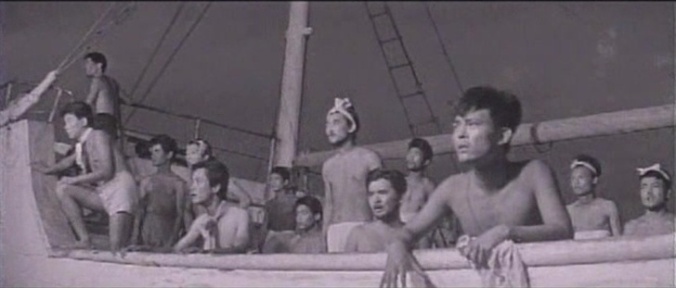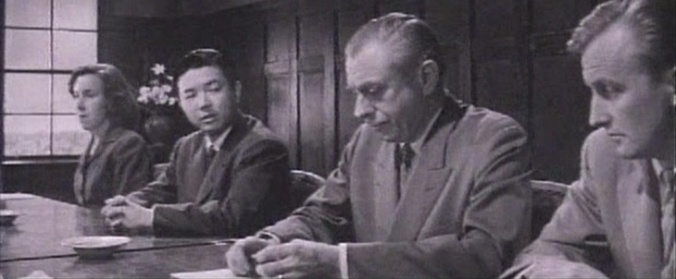
The crewmen observe the mushroom cloud in the distance
When the US tested the first hydrogen bomb at Bikini Atoll in 1954, the crew of a small Japanese fishing boat, the Lucky Dragon #5, became accidental witnesses, and victims, of the blast. The incident seared itself into Japan’s national consciousness, leading to a reinvigoration of Japan’s anti-nuclear stance and to public activity that would eventually produce the 1960 protests/riots against a new treaty with America. The incident also triggered the anti-nuclear, and perhaps anti-American, Godzilla in its original form, although Americans didn’t know it at the time, because all that was cut out of the American version. Made five years after the incident, this is the story of the crewmen themselves.
Kaneto Shindo had dealt with nuclear issues previously in his third feature as writer/director, Children of Hiroshima, a movie remarkable for its restraint and understatement. Lucky Dragon #5 is even more restrained, basically taking the form of a documentary re-enactment told without narration. As such, it is photographed and edited as simply as possible, without odd angles or dramatic lighting. Thus we see the crew set sail, with families on the dock to see them off. We follow their daily life on the ship and get some detail into tuna fishing as it was practiced at the time, each fish caught by baited hook on an individual steel cable, hauled aboard, stunned with a hammer blow, then stabbed and gutted and dropped into the ice filled hold. Unfortunately, the crew catches only sharks in their first area, so they decide to move farther south, where they begin to be successful. But one morning they are shocked by the sun rising in the west, followed by a mushroom cloud, and then several seconds later, a sound wave that blows men over and threatens the boat. Shortly afterward, a strange ash settles over them, and they take off for home as quickly as possible, afraid American aircraft might spot them and think they are spies.*
When they arrive home, they are all blackened, but gradually this does fade away.

A sailor returns to his wife after having his radioactive hair shaved
It is quickly determined that all have been radioactively poisoned, and are rushed into treatment, eventually all taken to Tokyo where the doctors who had studied and treated victims of Nagasaki and Hiroshima can be brought in, and we follow the steps of diagnosis, analysis, and treatments through the death of one of the crew.
Only when we reach the deathbed scenes is there any sense that Shindo is trying to underline a dramatic moment. Just as in Children of Hiroshima, he goes out of his way to downplay any melodrama. Gradually we realize that Jikichi Uno is the central character, but there is only minimal differentiation of the crew members.
Perhaps the most striking aspect to me is the lack of anger. No one gets mad at the Americans. We see no crowds outside the American embassy, no TV or news editorials condemning the Americans, no political statements other than a promise that the government will see the men and their families are taken care of properly. The only emotionalism comes from three prostitutes who break into the examination and demand the Geiger counter be run over them too, since they slept with some of the sailors.
We have seen this sense of acceptance as a steady stream in many other Japanese movies about “average” people. Things are what they are, so what is the point of shouting and screaming and fighting? Things will still be the same anyway. Only at the deathbed do we even see tears.
The Americans send specialists to help, but of course none speak Japanese, though surprisingly one is a woman.

The Americans try to negotiate
There is one tense moment when the Americans ask for patient transfers in order to conduct their own tests, which the Japanese doctors refuse as nearly point blank as Japanese manners (and translators) allow, so the Americans finally agree to do their tests at the Japanese hospitals (though we don’t see them being done). Even before this, many of the men had already refused to be transferred to American military hospitals, for fear the Americans will actually jail them as spies. And it should be noted that the treatment is hampered to some extent by the American refusal to release information about the contents of the ash, because it might reveal secret information about the new bomb. It should also be noted that the one thing the men on the boat really want from the Americans is the one thing they are never offered: an apology.
Hikaru Hayashi provides a jaunty ear-worm theme for the early, happier parts of the cruise that might have dropped in from a British sailing movie of the time, but the music essentially gets out of the way in later scenes, which further enhances the documentary approach of the movie.
This being a Kaneto Shindo movie, Nobuko Otowa appears as Uno’s wife, but it is no starring role. She is barely present until the death scene. Sharp eyes may recognize the pipe-smoking American professor (what American Professor in fifties movies didn’t smoke a pipe, I wonder) as Harold Conway, who was the mysterious American “husband” in Crazed Fruit.
I am hardly in a position to vouch for the accuracy of the various details, but the mixture of real documentary footage with actors on the boat scenes is seamless and certainly provides a sense of reality to the whole. Similarly, the huge crowds seen mourning across the nation suggest more documentary footage mixed into an otherwise low-budget movie** without a star, and the refusal to single out a handful of characters for dramatic scenes further suggests that Shindo was trying to stay faithful to the facts available to him.
For Americans, it was a little known incident, now long forgotten by all but specialists, so it is interesting to be reminded of it, and to be reminded that there was another viewpoint from our own.
- * A safe zone had been cleared around Bikini, and the Lucky Dragon #5 was well outside it, but this was the first hydrogen bomb test and the effects reportedly were felt far outside the expected safe zone.
- ** The casting as the lead of Uno, another of the numerous “Oh, yeah, that’s What’s-His-Name” actors in the industry at the time, indicates the available budget as clearly as anything on screen.
Pingback: I Live in Fear / Reccord of a Living Being / Ikimono no kiroku (1955) | Japanonfilm